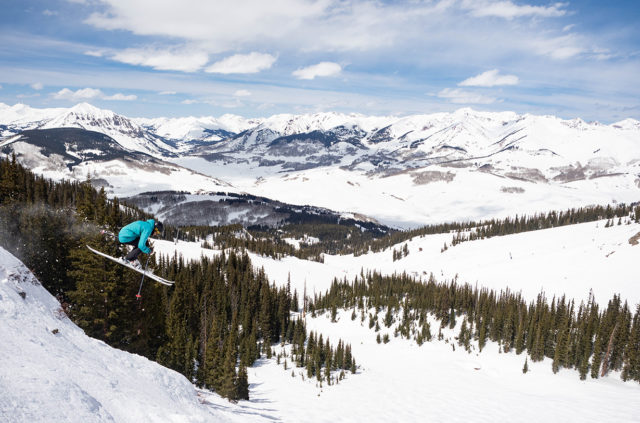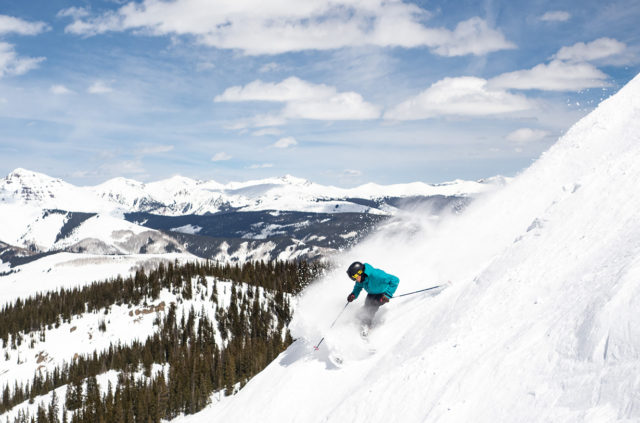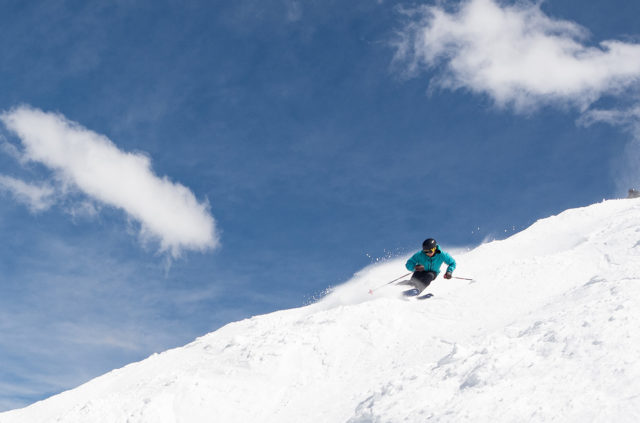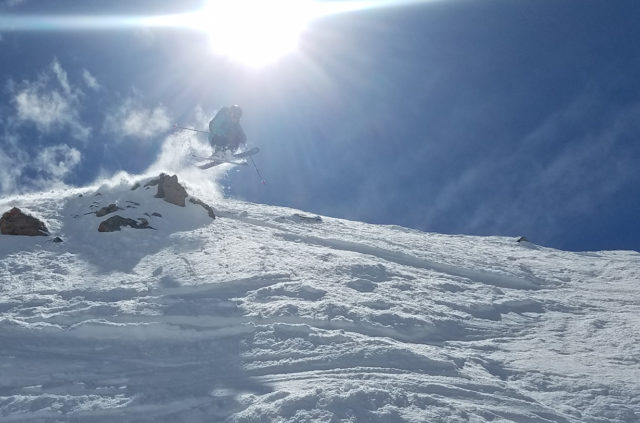Ski: 2019-2020 Armada ARV 96 Ti, 184 cm
Available Lengths: 163, 170, 177, 184 cm
Blister’s Measured Tip-to-Tail Length: 182.0 cm
Blister’s Measured Weight per Ski: 2100 & 2118 grams
Stated Dimensions: 126-96-118 mm
Blister’s Measured Dimensions: 125.7-95.3-117.6 mm
Stated Sidecut Radius (184 cm): 20 meters
Measured Tip & Tail Splay (ski decambered): 59 mm / 49 mm
Measured Traditional Camber Underfoot: 6-7 mm
Core: Poplar/Ash + Titanal (2 layers) + Fiberglass Laminate
Base: Sintered “S7”
Factory Recommended Mount Point: -2.6 cm from center; 88.4 cm from tail
Boots / Bindings: Nordica Strider 120; Salomon S/Pro 130 / Salomon Warden MNC 13
Test Location: Crested Butte, CO
Days Skied: 8

Intro
The Armada ARV 96 Ti, part of their limited-edition “Zero” collection, sits in a unique spot in the market. It’s built on the same shape and rocker profile as the standard ARV 96, which is a freestyle-oriented all-mountain ski. But the ARV 96 Ti has — you guessed it — titanal in its layup.
There aren’t many freestyle-oriented, metal-laminate skis out there. So let’s take a closer look at the ARV 96 Ti to get a better idea of how it compares to the rest of the market.
What Armada says about the ARV 96 Ti
“For those that need a little extra mustard than the hot dogger crowd, the new Armada ARV 96 Ti is a hard-charging twin that’s crafted to crush from first bell. Built in the same chassis as the ARV 96, this ski boasts two layers of full-length, full-width Titanal for supreme dampening and handling at speed for the confident skier that refuses to live life in slow motion.”
Based on what we’ll discuss in the next sections, “hard-charging twin” seems like a pretty good description of the ARV 96 Ti. It’s also interesting that the mention of the ARV 96 Ti being a “twin” is about the only hint that Armada gives us that this is a shape designed for throwing tricks.
Shape / Rocker Profile
The ARV 96 Ti has the same exact shape and rocker profile as the standard ARV 96. The ski has what I’d call a “moderate” amount of taper — it’s more tapered than some skis like the Dynastar Menace 98 and Rossignol Black Ops 98, but less tapered than others like the K2 Poacher and J Skis Allplay.
The ARV 96 Ti’s rocker profile is similarly moderate. It has a slightly deeper tip rocker line than the Black Ops 98, Nordica Soul Rider 97, and Faction Candide 2.0, but its tip rocker line isn’t as deep as some skis like the Moment PB&J and Faction Prodigy 2.0 & 3.0.
The ARV 96 Ti’s tail rocker line is a bit shallower, but I’d still call it a slightly rockered twin tail (as opposed to a fully cambered twin).
The last noteworthy thing here is the ARV 96 Ti’s camber — it’s got a lot at around 6-7 mm.
Flex Pattern
Here’s how we’d characterize the flex pattern of the ARV 96 Ti:
Tips: 6
Shovels: 6.5-7
In Front of Toe Piece: 7.5-9
Underfoot: 9.5
Behind the Heel Piece: 9.5-8.5
Tails: 7.5-6
The ARV 96 Ti’s flex pattern feels very similar to the flex pattern of Armada’s other metal-laminate freestyle ski, the ARV 106Ti. Both skis start fairly soft at the ends, but as soon as you get to the portion of the ski that has sidewalls (as opposed to the capped tips and tails), the flex ramps up quickly. And given that the sidewall portion comprises about 75% of the ARV 96 Ti, that means most of the ski is quite strong.
Compared to the Menace 98, the ARV 96 Ti stiffens up a bit quicker as you move toward the middle, and the ARV 96 Ti’s tips and tails are a touch stiffer. Overall, the flex pattern of the ARV 96 Ti is fairly similar to the Black Ops 98’s, but the ARV 96 Ti is a touch softer around the shovels.
Mount Point
The ARV 96 Ti has a very progressive mount point of around -2.6 cm from center. That puts it squarely in line with other freestyle-oriented skis like the Faction Candide 2.0, ON3P Magnus 102, and Line Blend. We’ll be playing around with the mount point on the ARV 96 Ti to get a better idea of how it responds at different mount points, and to the correspondingly different skiing stances and styles.
Weight
The ARV 96 Ti is not a particularly light ski at a little over 2100 grams per ski for the 184 cm length. That’s not crazy heavy compared to more directional metal-laminate skis, but it is notably heavier than some other skis in the all-mountain-freestyle category.
For reference, here are a number of our measured weights (per ski in grams) for some notable skis. As always, pay close attention to the length differences to keep things more apples-to-apples.
1629 & 1684 Elan Ripstick 96, 180 cm (17/18–19/20)
1734 & 1750 Renoun Endurance 98, 184 cm (18/19)
1758 & 1774 Moment Commander 98, 178 cm (18/19)
1800 & 1824 Luke Koppa’s Romp Skis 100, 183 cm (18/19)
1807 & 1840 Atomic Bent Chetler 100, 188 cm (18/19–19/20)
1829 & 1838 Faction Prodigy 2.0, 184 cm (18/19)
1848 & 1903 Line Sick Day 104, 186 cm (17/18–19/20)
1863 & 1894 Blizzard Rustler 9, 180 cm (18/19–19/20)
1894 & 1980 Black Crows Daemon, 183.6 cm (17/18–19/20)
1921 & 1968 Head Kore 99, 188 cm (18/19–19/20)
1925 & 1937 Liberty Helix 98, 186 cm (18/19–19/20)
1937 & 1945 Fischer Ranger 94 FR, 184 cm (19/20)
1966 & 1973 Liberty Origin 96, 187 cm (18/19–19/20)
1985 & 2006 Parlor Cardinal 100, 185 cm (16/17–18/19)
1998 & 2044 4FRNT MSP 99, 181 cm (17/18–18/19)
1950 & 1977 Blizzard Rustler 10, 188 cm (17/18–18/19)
2002 & 2014 J Skis Allplay, 184 cm (16/17–18/19)
2007 & 2029 Armada Invictus 99 Ti, 187 cm (18/19–19/20)
2019 & 2022 Rossignol Black Ops 98, 182 cm (18/19–19/20)
2031 & 2038 Faction Candide 2.0, 184 cm (17/18–19/20)
2049 & 2065 Volkl Mantra M5, 177 cm (18/19–19/20)
2050 & 2080 ON3P Wrenegade 96, 184 cm (18/19)
2053 & 2057 Atomic Vantage 97 Ti, 188 cm (18/19–19/20)
2067 & 2074 Line Blend, 185 cm (15/16–19/20)
2085 & 2096 Dynastar Menace 98, 181 cm (19/20)
2100 & 2118 Armada ARV 96 Ti, 184 cm (18/19–19/20)
2101 & 2104 Fischer Ranger 102 FR, 184 cm (18/19–19/20)
2111 & 2125 J Skis Vacation, 186 cm (18/19)
2115 & 2149 J Skis Masterblaster, 181 cm (16/17–18/19)
2118 & 2139 Nordica Soul Rider 97, 185 cm (15/16–19/20)
2124 & 2137 Blizzard Bonafide, 180 cm (17/18–19/20)
2126 & 2136 ON3P Magnus 102, 186 cm (18/19)
2131 & 2189 Nordica Enforcer 100, 185 cm (15/16–19/20)
2133 & 2134 Faction Prodigy 3.0, 183 cm (18/19–19/20)
2233 & 2255 Nordica Enforcer 104 Free, 186 cm (19/20)
2311 & 2342 K2 Mindbender 99Ti, 184 cm (19/20)
Some Questions / Things We’re Curious About
(1) We don’t see many metal-laminate skis with freestyle-oriented shapes, so how will the ARV 96 Ti compare to the skis in the two categories it seems to combine?
(2) Will more directional skiers still get along with the ARV 96 Ti, given its forward mount point?
(3) How much playfulness does the ARV 96 Ti lose compared to lighter and / or softer freestyle skis?
Bottom Line (For Now)
The Armada ARV 96 Ti looks pretty straightforward — take Armada’s ARV 96Ti’s freestyle ARV 96 and bump the stability up a notch with the addition of two layers of titanal. But is it really that straightforward on snow? Blister Members can check out our Flash Review linked below for our initial on-snow impressions, and then stay tuned for our full review.
Flash Review
Blister Members can now check out our Flash Review of the ARV 96 Ti for our initial impressions. Become a Blister member now to check out this and all of our Flash Reviews, plus get exclusive deals and discounts on skis, and personalized gear recommendations from us.
FULL REVIEW
As I’ve noted in other reviews, I love — and am always looking for — skis that combine both stability and playfulness. I like to slash, jump, and occasionally spin / flip around the mountain, but I also really appreciate skis that smooth out and hold up to rougher snow and higher speeds.
That combo can be fairly difficult to find. There are a few skis out there that do a pretty good job of balancing stability and playfulness, but most end up leaning more toward one end of the spectrum or the other.
So, where does the metal-laminate Armada ARV 96 Ti fall?
Slush / Spring Conditions
I spent a lot of time skiing the ARV 96 Ti in the spring, which means I got to ski it in one of my favorite conditions — soft, forgiving slush. And, like the ARV 106Ti, I loved the ARV 96 Ti in slush.

The ARV 96 Ti feels pretty stiff on snow despite not hand-flexing super stiff. This meant that it did a good job of blasting through the deeper slush without feeling like the front of the ski was folding up on me (I’m 5’8”, 155 lbs, and skied the 184 cm version).
At the same time, the ARV 96 Ti was easy to throw sideways when I wanted to shut things down. Despite not being very tapered or having a ton of rocker, I never found myself thinking that the ARV 96 Ti felt too “locked in” or difficult to slide. There are some surfier skis in this class (e.g., Faction Prodigy series), but for a 96mm-wide ski, the ARV 96 Ti was adequately loose, even in deeper slush. And if you’re coming from directional skis with flatter tails, I think you’ll find the ARV 96 Ti to feel significantly easier to slash and slide around.
Slush tends to give me a completely unwarranted sense of self-confidence. The landings are soft, I don’t care as much about getting slammed, and the sun’s usually shining. All of this makes me try stuff I probably shouldn’t, and the ARV 96 Ti is the perfect ski for this. It’s super solid on landings, still retains a notable amount of pop for take offs, and is easy to shut down once I realize I’m not as good as the slush made me believe. For skiing fast and going big in slush, the ARV 96 Ti is one of the best skis I’ve been on.
But the ARV 96 Ti isn’t a ski that only excels when the snow is soft and forgiving.
Chalk
Like the ARV 106Ti, the ARV 96 Ti has a really nice, smooth feel on firmer snow. I like Jonathan Ellsworth’s talk about a ski’s “suspension,” and if I were to make an analogy to mountain bikes, I’d say the ARV 96 Ti’s suspension feels like that of a ~130mm Trail bike. The ARV 96 Ti isn’t great for absorbing really big impacts (that’s where a bigger, heavier, and more directional ski seems to make more sense). But the ARV 96 Ti does do a really good job of muting out the smaller impacts, like skiing fast on chalky, somewhat inconsistent steeps.

It’s not some ultra-cush charger, but the ARV 96 Ti feels more calm and composed on firm snow than most all-mountain-freestyle skis I’ve been on. And the ARV 96 Ti’s edge hold also feels quite good. On the ARV 96 Ti, I had no problem skiing the steeps around Crested Butte as fast as I would on similarly heavy, directional all-mountain skis. But again, unlike those directional skis, the ARV 96 Ti is easier to slash, and it feels way more balanced in the air.
Crud
Once the snow got really variable (think chunks that are 3”+ and pretty firm), I did have to slow down a bit on the ARV 96 Ti compared to similarly heavy directional skis.

The ARV 96 Ti maintains its nice, damp feel, but its more centered mount point meant that I couldn’t drive it quite as hard as more directional skis. When skiing fast through crud, I find that being able to drive the front of a ski really hard helps keep its tips tracking. Even mounted around -4.5 cm from center (-2 cm from recommended), the ARV 96 Ti still felt best when skied with a fairly neutral stance. I could drive the tips a bit, but not enough to make me really want to charge through nasty snow.
All that said, if you’re coming from skis with forward mount points and ski with a pretty neutral / centered stance, I think the ARV 96 Ti will feel very stable. Because once you take stance out of the equation, the ARV 96 Ti’s damp feel and strong flex pattern put it at the upper end of the stability spectrum, particularly when compared to other freestyle-oriented skis.
Groomers
I don’t really have anything particularly positive or negative to say here. The ARV 96 Ti carves nicely, holds an edge pretty well, and doesn’t feel completely dead coming out of a turn.
The ARV 96 Ti isn’t some super energetic, snappy carver like the Line Sir Francis Bacon, and it isn’t a steamroller of a ski like the Head Monsters, K2 Mindbender 99Ti, etc. But the ARV 96 Ti makes the groomers between the park, cliffs, side-hits, etc. fun enough without feeling unstable or unpredictable. Just keep in mind that it’s not the best choice if you really love to drive the front of your skis.
Moguls, Trees, and Tight Terrain
This is one area where I’ve really come to like freestyle-oriented skis that have a bit of weight to them. The ARV 96 Ti is easier to pivot around vs. skis with less tail rocker, yet it’s still strong enough to be skied quite hard in steep bumps, trees, etc. And the ARV 96 Ti’s softer tips and tails keep it from feeling particularly punishing.
I wouldn’t put a beginner or low-intermediate on this ski, but I think the ARV 96 Ti is forgiving enough for higher-intermediates and above to get along well with it, while being strong enough to support those skiers as they progress.
And when the bumps got really firm, I again appreciated the smooth feel of the ARV 96 Ti. While I can have a lot of fun on light, poppy freestyle skis like the Sir Francis Bacon, those skis start to be a lot less fun when conditions are really firm. The ARV 96 Ti is still fairly loose and playful, but it stays much more composed on firm, rough snow vs. lighter, softer skis.
Park / Playfulness
Some people would call the standard ARV 96 a park ski, and I spent a bit of time on the ARV 96 Ti in the park.
In the air, the ARV 96 Ti feels notably heavier and more sluggish than some other skis in its class, most of which are lighter. It still feels balanced in the air, but it’s not the best option for people who are looking to do a lot of really quick spins, techy rail tricks, etc. It’s certainly possible (just watch Quinn Wolferman on the ARV 96 Ti), but I think most skiers who are into techy, fast rail skiing would be better off on a lighter ski.

Similar story with butters — they’re possible, but the ARV 96 Ti is not the best ski for them. Its tips and tails are soft enough for me to bend the ends, but most of the ski is pretty stiff and doesn’t flex easily.
I don’t spend much time on rails though and I still suck at butters, so none of this was a real issue for me. And on jumps (where I’m not throwing huge spins), the ARV 96 Ti was really nice. It’s got a big sweet spot, and that portion of the ski is pretty stiff. So when I ended up too far forward or back, I was easily able to get myself back to center (whereas softer skis might have washed out on me). Similar story with under- or over-rotating spins — the ARV 96 Ti doesn’t catch that easily and it let me get away with sloppier landings than I could on less tapered skis.
The ARV 96 Ti does have a notable amount of tip and tail rocker, so it wouldn’t be my top recommendation for people who spend most of their time hitting really big jumps and appreciate a really stiff, fully cambered tail.
So the bottom line here is that, yes, the ARV 96 Ti’s higher stability does come at the cost of a bit of playfulness. This is most noticeable in its higher swing weight and stiffer flex. But for aggressive playful skiers who value playfulness and stability, it’s an excellent option. And for people who are coming from similarly heavy, directional, flatter-tailed skis, the ARV 96 Ti will feel significantly more playful.
Who’s It For?
I think the ARV 96 Ti makes the most sense for skiers with a freestyle background who are looking for a stronger, more stable ski that they can use to throw tricks all around the mountain at higher speeds. It feels similar to other freestyle skis in that you can ski it neutral, it’s balanced in the air, and it’s pretty easy to slide around. But the ARV 96 Ti also has a pretty smooth, composed feel on rough snow and holds up well to high speeds and big drops, making it stand out from most other freestyle skis in this class. And if you’re looking for more of a soft-snow-oriented ski with a similar feel, check out the Armada ARV 106Ti.
The ARV 96 Ti could also work well for more directional skiers who are looking for something more playful, but who don’t want to sacrifice all of the damp, stable feel of their metal-laminate directional skis. If you’re one of those people, the one thing I’d keep in mind is that the ARV 96 Ti feels best when skied with a pretty neutral stance. You can drive it a bit with the bindings moved back to around -5 cm from center, but if you’re someone who’s always over the front of your skis, you’ll probably want to opt for a ski with a mount point closer to -8 or -9 cm.
Bottom Line
The Armada ARV 96 Ti offers a combination not found in many other skis. It has much of the damp, smooth feel of directional metal-laminate skis, but packages that into a freestyle-friendly design. The result is a ski that is an excellent option for people who like to throw tricks or ski with a playful style, but want their skis to hold up to high speeds and nasty snow.
Deep Dive Comparisons: Armada ARV 96 Ti
Become a Blister Member or Deep Dive subscriber to check out our Deep Dive comparisons of the ARV 96 Ti to see how it compares to the Rossignol Black Ops 98, Dynastar Menace 98, Atomic Bent Chetler 100, Fischer Ranger 94 FR, Liberty Helix 98, Liberty Origin 96, J Skis Masterblaster, Moment Commander 98, Renoun Endurance 98, Nordica Enforcer 100, 4FRNT MSP 99, ON3P Wrenegade 96, and Blizzard Rustler 9.

This needs to be compared with the Kartel 96 as it seems to be most in line with it.
According to Armada’s mounting guide (https://armadaskis.com/en-us/mounting-guides/) this ski actually has 2 recommended mounting points one called “Freeride” (~5cm behind center) and one called “Freestyle” (~2,5 cm behind center). Even though the ski only has ONE “recommended line” printed on the ski (=”Freestyle”), Armadas own recommenation (green color in the sheet) is to go for the “Freeride” (~5cm behind) for the ARV 96 Ti (while the “Freestyle” mounting point is recommended for the non Ti version). Confusing? Yes it is! I own a pair and my recommendation is to go for Freeride (~5 cm behind). It is alos worth noticing that armada measures the recommended mount point from the tail in their mounting guide.
I.e. The ARV skis have 2 different recommended mounting points according to Armadas mounting guide (https://armadaskis.com/en-us/mounting-guides/) and for the ARV 96 Ti, Armadas recommendation is the “Freeride” mounting point which is ~-5cm from center, while the recommendation for the non Ti version is the Freestyle mounting point at ~-2,5 cm. This makes a lot of sense since the Ti version is more of a “twintip charger” while the non Ti has softer flex and is more of a park/freestyle ski. This is confusing for the consumer since Armada have only one “recommended line” (Freestyle) printed on the ski at ¨-2,5 cm (Freestyle) both for the Ti and non Ti version….:) :)….
Luke,
Looking forward to your experience with the mount points. I have mine at -2.5, and coming from a much more directional ski (Black Crows Atris) noticed it took a run or two to get used to the mount point. Could be just that I’ve never had that much tail behind me, but noticed it just needs me to be more “on” it/not sloppy with my technique. Then again, I guess this isn’t a surprise given the narrower platform with less rocker and higher camber height than the Atris. Still, curious if mounting farther back might change any of my current experience.